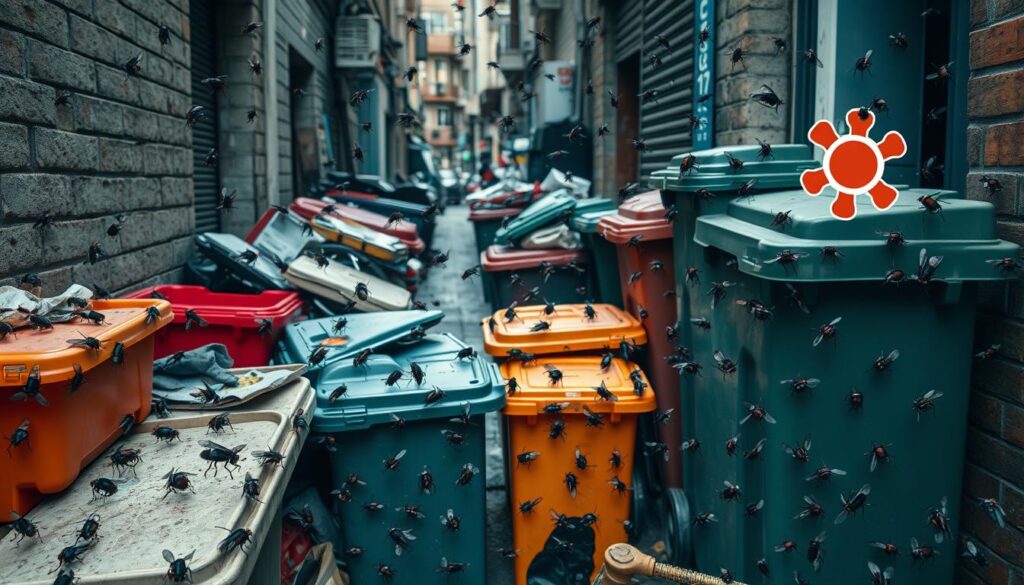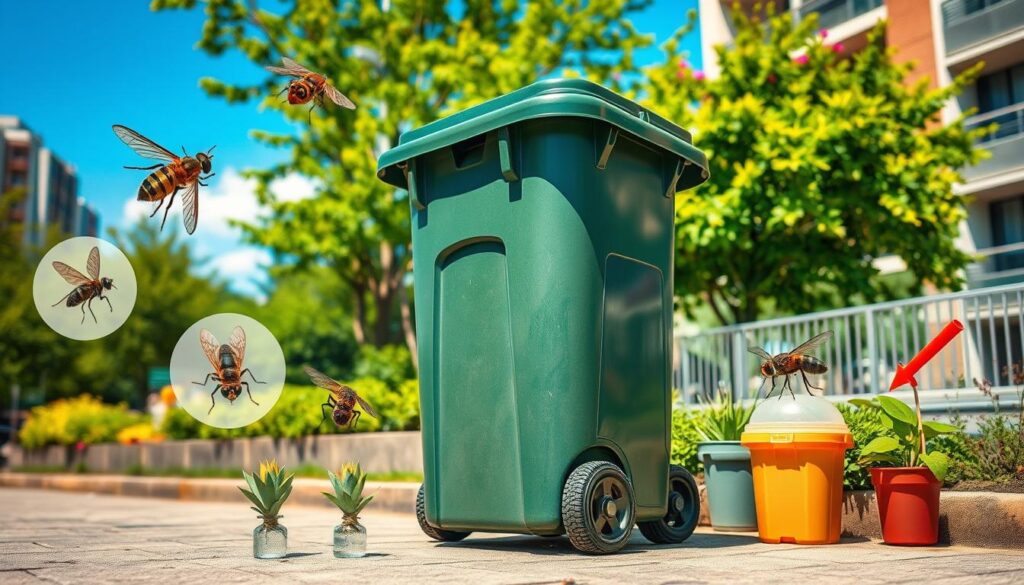Could your home be at risk from flies and the diseases they carry if waste strikes happen in Scotland? The country is getting ready for possible problems with rubbish and recycling. It’s very important to know the dangers that these pests can bring.
Key Takeaways
- Flies can spread harmful bacteria and viruses. This includes salmonella, E.coli, and campylobacter. These can cause serious food poisoning and diarrhoea.
- Flies love food waste and rubbish. So, overflowing wheelie bins are a perfect place for them to breed during strikes.
- Fly-borne diseases can be very serious. They can cause skin problems or even life-threatening illnesses like cholera and typhoid fever.
- It’s important to prevent flies from coming into your home. Using fly traps and deterrents can help keep your family safe.
- Keep an eye on the situation and follow public health advice. This is key to keeping your family healthy.
Flies: A Nuisance and Health Hazard
Flies are a big problem in both country and city areas in the UK. The housefly is a common pest in towns and farms. It can grow into a big number quickly.
Calliphorids, like the green blowfly, are found near dead animals and dirty places. Flesh flies also live in cities, drawn to dead animals and rotting meat.
Flies as Vectors of Disease
Flies carry over a hundred diseases that can harm humans. They pick up these diseases from animal waste, human poop, and rotting things. This can spread diseases like malaria, dengue fever, and Zika virus.
“The order Diptera consists of ‘true flies’ with only two wings, making it one of the largest groups of insects.”
Houseflies grow to about ½ inch as larvae and can fly far to find places to lay eggs. Blow flies are similar in size and like garbage and dead animals. Flesh flies are a bit bigger and prefer dead meat.
Stable flies drink animal blood, including human blood. They lay eggs in rotting straw and manure.
Fruit flies like sweet things and ripe fruit. They have tan bodies and red eyes. Phorid flies are small and dark, living in rotting things.
Drain flies live in raw sewage and other standing water. They can survive in wet, gooey places. Fungus gnats look like tiny mosquitoes and live where fungus grows.
Fly-borne Diseases
Flies are a big danger to our health. They can spread many fly-borne diseases. These insect vectors carry and spread harmful germs.
One well-known disease is malaria. It’s spread by mosquitoes. Other diseases like dengue fever, yellow fever, Zika virus, West Nile virus, and chikungunya are also carried by flies.
House flies can spread about 65 diseases, says the World Health Organisation. They are a big problem in the food industry. They can cause food poisoning and other serious infections.
- Flies can spread Cholera, Typhoid Fever, Dysentery, Salmonella, Trachoma, Conjunctivitis, Zika virus, and Yellow fever.
- To stop them, keep things clean, use fly traps, and apply insecticides safely. Also, install screens, manage waste well, stay clean, and use treated bed nets.

Flies can make us sick by landing on dirty things. They then spread germs to food or surfaces. This can make us very ill.
“Houseflies are responsible for spreading diseases like cholera, typhoid fever, and dysentery by picking up harmful bacteria from contaminated water or feces and spreading it to food or surfaces.”
We need to fight fly-borne diseases in many ways. We must prevent and control them. We also need to keep watching and checking to keep everyone safe and healthy.
Breeding Grounds: Wheelie Bins and Refuse
Wheelie bins and refuse areas can quickly become a breeding ground for flies and other pests. They attract flies because of the organic waste, like food scraps. If these bins are not cleaned well, it’s a perfect place for disease to spread.
Fly Breeding Sites
Houseflies love rotting, fermenting, or moist organic matter. This is often found in wheelie bins and refuse sites. They find food, water, and shelter here, helping them to thrive and spread diseases like malaria, dengue fever, yellow fever, Zika virus, West Nile virus, and chikungunya.
Bad hygiene, like dead animals or dirty bins, makes things worse. Flies can move far, spreading diseases from one place to another.
| Bacteria | Health Risks |
|---|---|
| Salmonella | Mild to severe food poisoning |
| E. coli | Bloody diarrhea, severe anemia, kidney failure, and other infections |
| Listeria | Serious illness, especially for vulnerable individuals like pregnant women and those with compromised immune systems |
Cleaning wheelie bins well can help. Use green cleaners to cut down on bacteria. This makes homes cleaner and less appealing to pests.
“Neglecting proper bin cleaning can result in the proliferation of bacteria commonly linked to food poisoning cases in the UK, such as Salmonella, E-coli, and Listeria.”
Prevention and Control Measures
To fight fly-borne diseases and insect vectors, we need many steps. Keeping things clean is very important. It stops flies from finding food, shelter, and places to breed.
Keep doors shut and fix window screens to stop flies from getting in. Use traps or other ways to get rid of flies fast. Also, clean wheelie bins, paladins, and skips well. Put rubbish in sealed bags.
Using chemicals should be a last choice. It might not solve the real problem. Using many ways to control pests is best. This helps fight mosquito-borne illnesses like malaria, dengue fever, yellow fever, Zika virus, West Nile virus, and chikungunya.
| Intervention | Impact on Fly Population | Impact on Diarrhoea Incidence in Children |
|---|---|---|
| Insecticide Spraying | Significant reduction in fly population during peak months | Reduction in the incidence of diarrhoea in children under five years of age |
| Baited Fly Traps | No significant effect on fly population | No significant effect on diarrhoea incidence in children under five years of age |
By getting rid of fly breeding spots and insect homes, we can lower fly-borne diseases risk. This keeps everyone healthier. We must always check and improve our efforts.

Monitoring and Assessment
It’s very important to watch and check fly numbers to stop fly-borne diseases and keep people healthy. We use different ways to see how many insect vectors there are. These bugs help spread disease transmission.
One common way is using baited traps. These traps draw in and catch flies for us to count and identify. Sticky ribbons or cards are also used in key spots to watch fly activity and where they land. These spot cards, about 80mm x 125mm, are put where flies like to rest. The number of spots shows how many flies are around.
The Global Vector Control Response 2017-2030 says to put at least five spot cards in a place where flies might breed. Leave them for a week. If there are 100 spots or more on each card, it means there are a lot of house fly problems. This calls for quick action to control them.
The Integrated Vector Management (IVM) plan, in the Global Strategic Framework, stresses the need for smart choices. This includes checking vector-borne diseases like malaria, dengue fever, yellow fever, Zika virus, West Nile virus, and chikungunya.
By always watching and checking, health teams can choose the best fly control plans. This helps keep communities safe and lessens the harm from mosquito-borne illnesses.
“Independent evaluation is required for the public health value of new vector control tools and technologies.”
Impact on Public Health and Nuisance
Flies are a big problem for public health and cause a lot of trouble. They carry fly-borne diseases like malaria and dengue fever. This makes them a big worry for everyone.
Flies also make it hard to enjoy the outdoors, especially when eating or cooking. Seeing lots of flies makes places feel dirty and unhappy.
Research shows house flies grow in bad conditions. They pick up bacteria that helps them grow. Flies are drawn to places like bins and trash.
The Clean Neighbourhoods and Environment Act of 2005 says flies can be a problem. If there are too many flies in a room, it can bother people a lot.
| Fly-borne Diseases | Transmission and Risks |
|---|---|
| Malaria | Transmitted by infected mosquitoes, leading to fever, chills, and potentially life-threatening complications. |
| Dengue Fever | Spread by mosquitoes, causing flu-like symptoms and potentially severe complications, including internal bleeding and organ impairment. |
| Yellow Fever | Transmitted by infected mosquitoes, leading to symptoms like fever, chills, headache, and in severe cases, liver damage and bleeding. |
| Zika Virus | Primarily spread by mosquitoes, causing mild symptoms but potentially leading to birth defects in pregnant women. |
| West Nile Virus | Transmitted by infected mosquitoes, leading to fever, headache, and in rare cases, neurological complications. |
| Chikungunya | Spread by mosquitoes, causing fever, joint pain, and potentially leading to chronic arthritis-like symptoms. |
To deal with flies, we need to stop them before they start. We must understand how they spread diseases. This way, we can keep our places safe and happy.
Protecting Your Home and Community
To keep your home and community safe from fly-borne diseases and insect vectors, follow some important steps. Keep doors and windows shut. Fix any broken screens and get rid of wet straw and uncovered bins.
Don’t forget to store waste properly. Fly traps can help, but they’re not enough on their own. Chemicals should be a last choice, as they might not solve the problem for good.
Practical Tips
Here are some easy ways to keep your home and community safe:
- Make sure all doors and windows are sealed and screened to keep flies out.
- Keep your wheelie bins clean to stop flies from breeding.
- Dispose of organic waste right and store it in covered bins to stop flies.
- Place fly traps around your home to catch more flies.
- Don’t rely on chemicals to control flies, as they can cause more problems.
- Know about diseases like malaria, dengue fever, yellow fever, Zika virus, West Nile virus, and chikungunya in your area and take steps to avoid them.
By following these tips, you can help keep your home and community safe from fly-borne diseases. A clean and healthy environment is essential for everyone’s health.
Conclusion
Flies carry many diseases and are very dangerous. They spread harmful germs and can make people very sick. Places like wheelie bins are perfect for them to breed.
Keeping your home and area clean is key to staying healthy. Make sure to clean wheelie bins often. This helps stop flies and keeps everyone safe.
By following these tips, we can all help keep our community healthy. We can fight diseases like malaria and dengue fever. This makes our environment safer for everyone.
